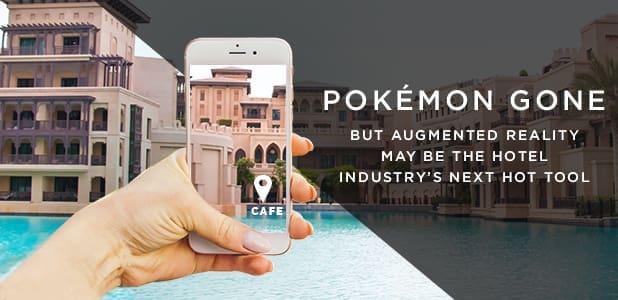
Did you catch ‘em all?Pokémon GO was the hot mobile game that had us scrambling this summer in an attempt to catch virtual characters in the real world.While the Pokémon GO craze may have been relatively short lived, the app has been downloaded more than 500 million times to date, and the phenomenon has been credited with popularizing augmented reality (AR).Though the technology has been around for a few years (remember Google Glass?), most mainstream brands are only now scratching the surface of AR and its applications. Just this week, Apple CEO Tim Cook predicted that “a significant portion of the population of developed countries, and eventually all countries, will have AR experiences every day, almost like eating three meals a day.”As the applications and adoption of AR grows, the technology will undoubtedly transform storytelling across a multitude of industries, including hospitality.
WHAT EXACTLY IS AUGMENTED REALITY?
Augmented reality is the blending of both the real and virtual world.Most people are familiar with virtual reality, a realistic computer-generated environment that lets one experience a different reality, typically through the use of a VR headset, such as Google Cardboard or Oculus Rift.AR is different in that it uses the real world as its base and places virtual items in it.Virtual items appear when an “aura” (the industry term for an augmented reality digital element) is embedded into physical objects or real-world locations. That aura then dictates what information is projected on a user’s mobile screen. It can display anything from wayfinding tips, to historic info, to furniture, even that new tattoo you’re considering.With Pokémon GO, virtual creatures are brought to life in our world when viewed through the Pokémon G0 app. Characters interact with reality, sitting on our arm or flying around the park.
TECHNOLOGY AS STORYTELLER
There are already multiple AR apps designed specifically for travelers. Nearest Tube has helped direct people to the nearest London Tube station for years. Paris, Then and Now, offers visitors to the City of Lights a side-by-side glimpse of what various locations looked like throughout different periods of history.For hotels, the AR world is typically accessed via a proprietary app. Guests on-property simply point their device to receive customized information on their screen.Point in the direction of a guestroom and find out when the housekeeping staff last visited, or pull up menu recommendations and reviews while sitting at a bar.At larger properties, fire-up the app for wayfinding assistance. Resorts can even customize an AR-guided tour of its art, gardens or other points of interest.But it’s not all about leisure travel. AR holds the potential to support group sales as well.With fewer and fewer salespeople on-site, AR can help bridge the information gap when meeting planners visit. They may merely need to point at the ballroom for capacity details and configuration possibilities. Aim toward an outdoor venue and meeting professionals might preview a typical event setup.
OFF-SITE POTENTIAL
There’s plenty of pre-arrival outreach potential with AR as well.Imagine being able to showcase a hotel’s signature dish on a potential guest’s home dining table, or allow them to view the hotel pool out their back window in winter.The technology could even be tapped to entice guests from competitive properties. A well-placed aura at the airport might display Polynesian dancers and give arriving travelers a glimpse at a property’s luau, or display a bright bank of slot machines to promote a hotel’s casino.Since an aura can be placed just about anywhere, hotel teams can offer a glimpse of the guest experience at will.
THE TEACHINGS OF POKÉMON
If nothing else, the one thing the Pokémon GO sensation has reinforced is the importance – and potential – of mobile devices.In a world where one’s phone can be their room key, it’s not much of a stretch to believe it can also be their personal tour guide and concierge.Further, the mass adoption of Pokémon GO demonstrates that consumers are ready for emerging technologies under the right circumstances.Forbes recently conducted a survey showing that 79% of marketers want to create a customer-centric focus for marketing campaigns. AR just may be the technology that helps make this a reality.The opportunity for hotel teams to vastly expand engagement is ripe, and the possibilities, of course, are virtually endless.






